| |
Summary
|
|
'Les Soeurs Bronte'
The photo was found in France and in French on the reverse is written
"Londres - Les Soeurs Bronte." It is a photo on glass, known as a wet
plate collodion positive or ambrotype, but
these date at the earliest to the 1850s, after the death of Emily and Anne. If the title is
correct then it could only be a copy of an 1840s daguerreotype depicting L-R Charlotte,
Emily and Anne.
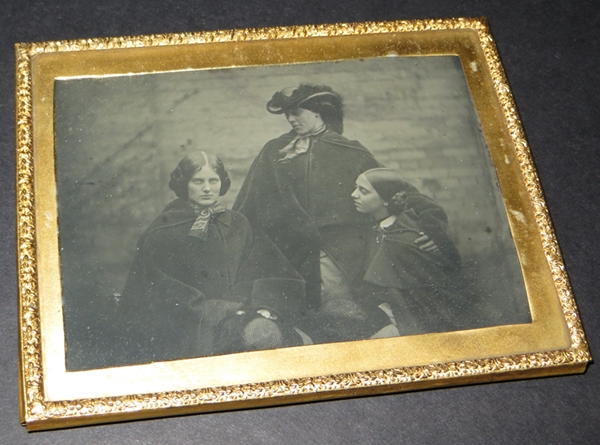
The two group portrait paintings of the sisters were copied by a Haworth
photographer in the 1850s for Martha Brown, the servant in the Bronte household. If this is
a copy of a group photograph of the sisters then it was probably made by John Stewart, keen
photographer and friend of Charlotte's publisher, George Smith.
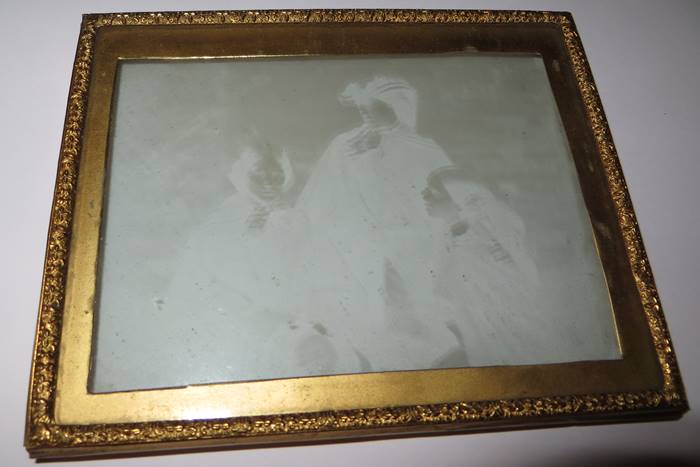
The photo viewed when the black backing card is
removed.
A collodion is in effect an early glass negative with the picture side
facing the person viewing it so the image is reversed. When the photo is printed on paper
it reverses the image again so Charlotte appears on the right, as seen
below. Whether it is an 1850s photo of three ladies,
or a copy of a daguerreotype depicting the Bronte sisters, this is what the 1850s
photographer saw when he took this photograph.
|
|
1840s
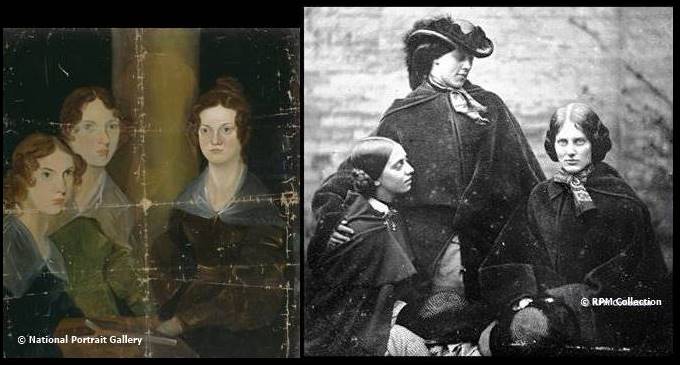
Comparing the photo with the only surviving group portrait known as the
'Pillar Portrait.'
The 1830s 'Pillar Portrait' should have had a balanced triangular
composition with Branwell forming the apex, but he painted himself out before the painting
was completed; the outline of his figure can just be seen. These facts were not known until
the 1950s when the NPG had the painting x-rayed. In the photo the sisters appear in the
same order but the triangular composition has been restored with Emily
seated higher. The painting was seen only by visitors to the Parsonage from
the 1830s until 1861 when it was taken to Ireland and hidden away until
1914.
All
three sisters were keen artists and would be aware of the emerging "new
art" of photography. When Emily and Charlotte arrived in Brussels (1842)
the first photographic studios were just opening there and the bookshop used by
Branwell and Anne in York (1844-5) was almost opposite the newly
opened daguerreotype studio. By January
1848
Charlotte was using
the word "daguerreotype" as a metaphor in her letters and is thought to
have been the first writer to use the term as a verb in a
novel.
In the 1840s the cost of a photo was miniscule
compared to having a full group portrait painted by an artist. Emily and
Anne were not famous because they published under
pseudonyms so any photo would be a personal
souvenir.
If there is no mention of a
photograph then it is not surprising as
the sisters could
be very secretive. They succeeded in publishing a book of poems
and three novels without the knowledge of their father, brother or servants,
even though they were all living under the same roof. When asked by her
publisher for portraits of her sisters, Charlotte denied that any existed,
yet within the Parsonage were Branwell's two group portraits and several
of her own portraits of her sisters. After Charlotte's death her widower
destroyed correspondence and suppressed images of the sisters by
burning most of one group portrait and hiding the other away for
five decades.

The hat worn by 'Emily' in the
photograph.
The hat
seen in the photo is a wide-awake style seen in fashion engravings c1856 but it
was produced in Britain from 1847. It was Known as a 'Jenny
Lind' named after the famous singer who was at the height of her fame in
September 1847 when she visited Yorkshire. Her concert in York was cancelled at
the last minute but 'Jenny Lind' hats, along with all the other 'Jenny
Lind' paraphernalia, would have been on sale in the shops in that year. The
hat was being sold in Hull and Leeds by November
1847.
Whether a photograph was ever taken
is not known but by early December 1847 the three sisters
were secretly published authors of what became three best selling
novels and Charlotte's earliest (known) use of the word
daguerreotype is about four weeks later in January
1848.
|
|
1850s
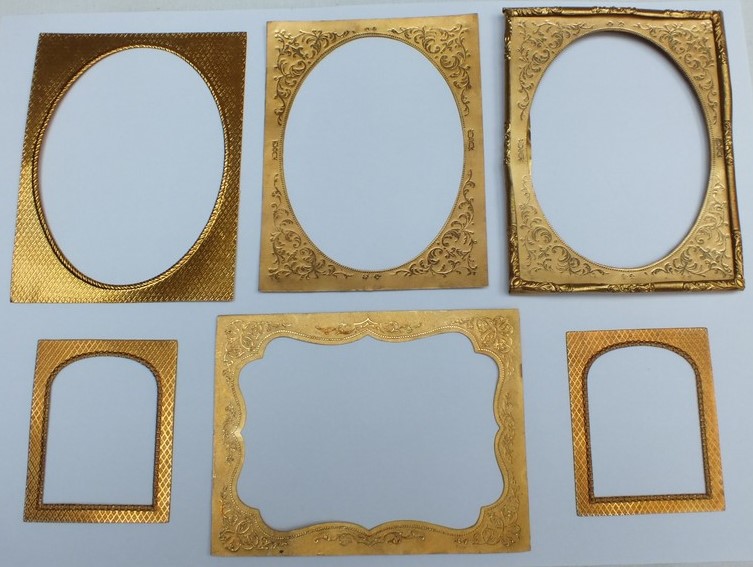
Collodion photos of the 1850s were normally placed in a frame with a machine-cut
metal mat between the glass photo and the glass in the frame and that was
the end product. Some of these mats were quite ornate but at the very least they were cut
straight. The mat in this photo is roughly hand cut, straight on one side only, which is
rare because most photographs were produced to display. At the Bronte Parsonage Museum
(BPM) is another cut in the same fashion and dated 1857. The two photos will be by the same
person and the only photographer living in France who visited Haworth in 1856-7 was John
Stewart. He was there on behalf of the publisher, George Smith, and Elizabeth Gaskell who
was compiling Charlotte's biography. Stewart was to there to
photograph Charlotte's portrait by George Richmond and take views of Haworth; these
were to be engraved and used to illustrate the biography.
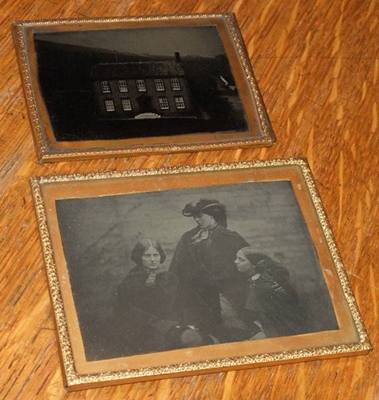
The photos are a type of early glass negative and throughout
this decade some photographers began using them to print the image on paper. John Stewart
was an experimental photographer who used paper negatives and
collodion negatives to make paper prints. For him, the image on glass was
merely a negative to be labelled and stored away.
This photo has "Londres - Les Soeurs Bronte" written on
the reverse, suggesting that this was the destination for the copy on paper, and there is
evidence that a print from this photo was in London in the early 1860s.
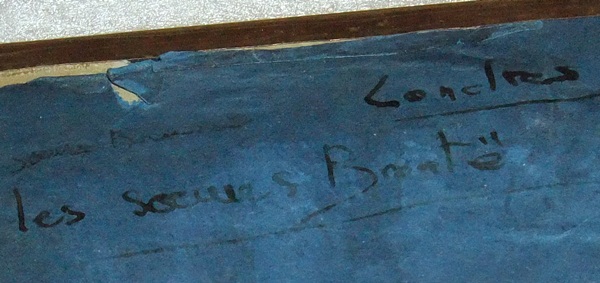
|
|
1860s
The first illustrations ever to be published in
connection with the Bronte sisters appeared in Charlotte's biography in 1857.
The first one to be created after this was an illustration for Charlotte's novel, Jane
Eyre. This was a watercolour by the artist/illustrator, Frederick Walker, commissioned in
1863 by the publisher, George Smith. The two men were on "intimate terms" at this point in
time and this was six years after another friend, John Stewart, had carried out
the photographic work for him at Haworth.
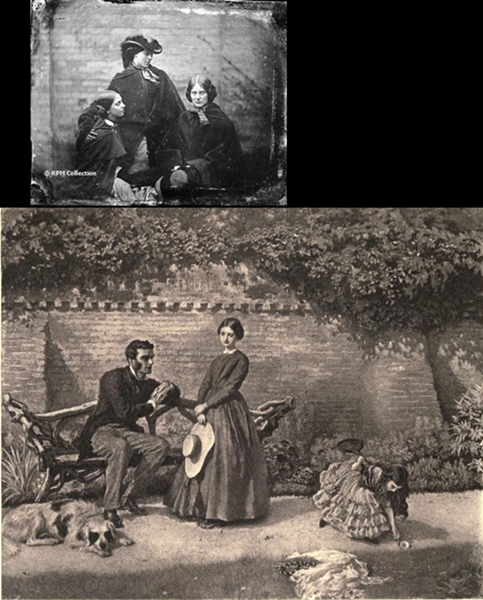
The photograph depicts Emily seated sideways on,
looking towards Charlotte, the author of Jane Eyre, who is seated holding a straw hat with
Anne below them. The setting is a garden and in the background is a brick wall with two
brick piers.
The watercolour depicts Rochester seated sideways
on, looking towards Jane Eyre who is stood holding a straw hat with Adele below them. The
setting is a garden and in the background is a brick wall with two brick buttresses.
When the heads of the three characters in the watercolour are turned to
the same angle as those in the photo there are more
similarities. They appear to have been transformed from those in the
photo, although some details remain.
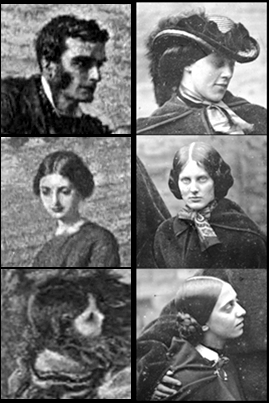
|
|
Comparing Portraits
There have been many flattered and wrongly identified portraits of the
sisters published over the years but the group portrait at the NPG is thought to be the
most accurate representation of them. Contemporary accounts from the 1850s concur that it
was poorly executed, but also that the family considered the likenesses to be good.
Elizabeth Gaskell noted in the 1850s Charlotte's "striking resemblance," even
though it had been painted in the 1830s.

Looking at the features, in both portraits Anne has an aquiline nose,
Emily a straight nose. The only problem is that Charlotte's hair is parted on the wrong
side and her mouth turns down on the wrong side. If this is a copy of an 1840s photograph
then this can be accounted for because daguerreotypes were reversed images; Charlotte would
be on the left as in the image below.
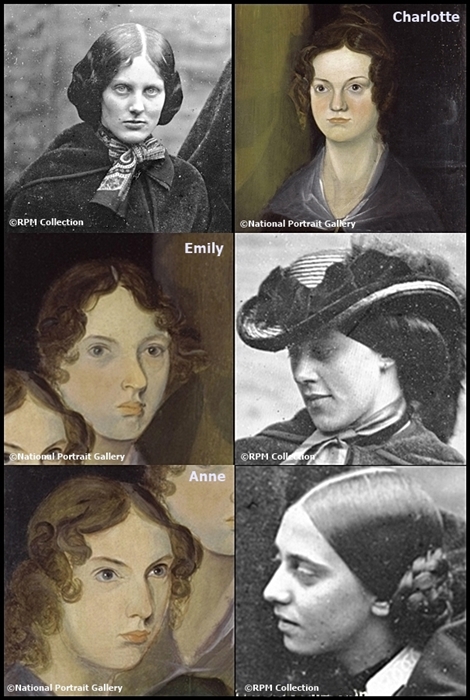
Detail
from 'The Bronte Sisters' (NPG 1725) (Charlotte, Emily,
Anne) compared with detail from the
photograph.
The orientation of the photo is explained on the page: "Is the Photo
an 1850s Copy?"
|
|
Lost Portraits
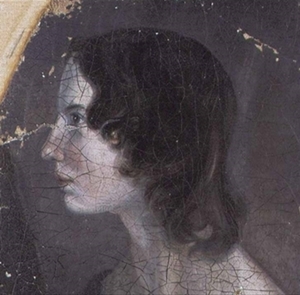 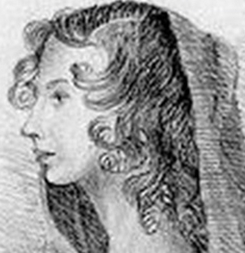
The Profile Portrait at the NPG is identified as Emily but this has been
disputed since it was first displayed in 1914. She is very like Charlotte's portrait
of Anne. Ellen Nussey stated that Anne was "quite different in appearance to the
others" and the few descriptions of Emily describe her as more
masculine-looking.
Charlotte's portraits of Anne have survived but, apparently, none of
Emily. One of these missing portraits is a pencil sketch of Emily by Charlotte,
owned by Martha Brown, and seen by William Robertson Nicoll in 1879.
|
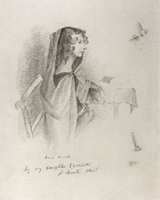
Pencil Portrait of Anne by
Charlotte.
|
MISSING
Pencil Portrait of Emily by
Charlotte.
|
|
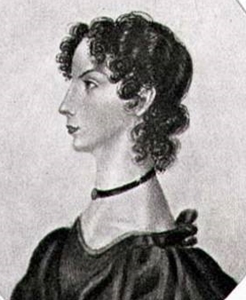
Miniature oval watercolour of Anne
by Charlotte.
|
MISSING???
Miniature oval watercolour of Emily by
Charlotte?
|
There is a miniature oval watercolour portrait of Anne by
Charlotte, but not one of Emily. There is an unidentified miniature oval
watercolour portrait by Charlotte and she looks like a younger version of 'Emily' in
the photograph. Whoever she is she resembles the maternal (Branwell) side of the
family.
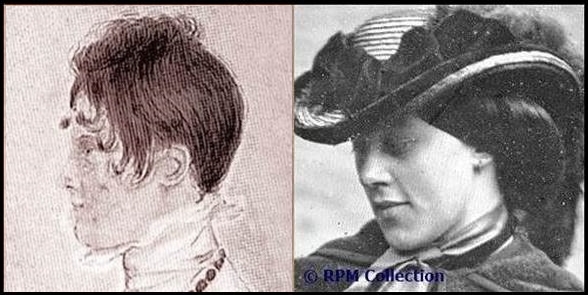
Left: Portrait
of an unknown woman by Charlotte Bronte (seen here in reverse) - the full portrait can be found in
Art of the Brontes.
Right: Emily in the photograph
|
|
Artwork?
The photo is unlikely to be three women posing as the Bronte sisters,
some form of artwork, because the photographer would have ensured that the photo was level.
This defect, and the distorted wall in the background, suggest that it is a copy of a
daguerreotype photographed at an angle. Photographs couldn't be reproduced in books at this
time, they had to be engraved, so instead of finding three ladies and a photographer it
would have been far less trouble to have an artist make a sketch.
If the photo is a copy of a daguerreotype then
hopefully the original photo survives and is one day found.
|
|
|
|

